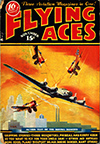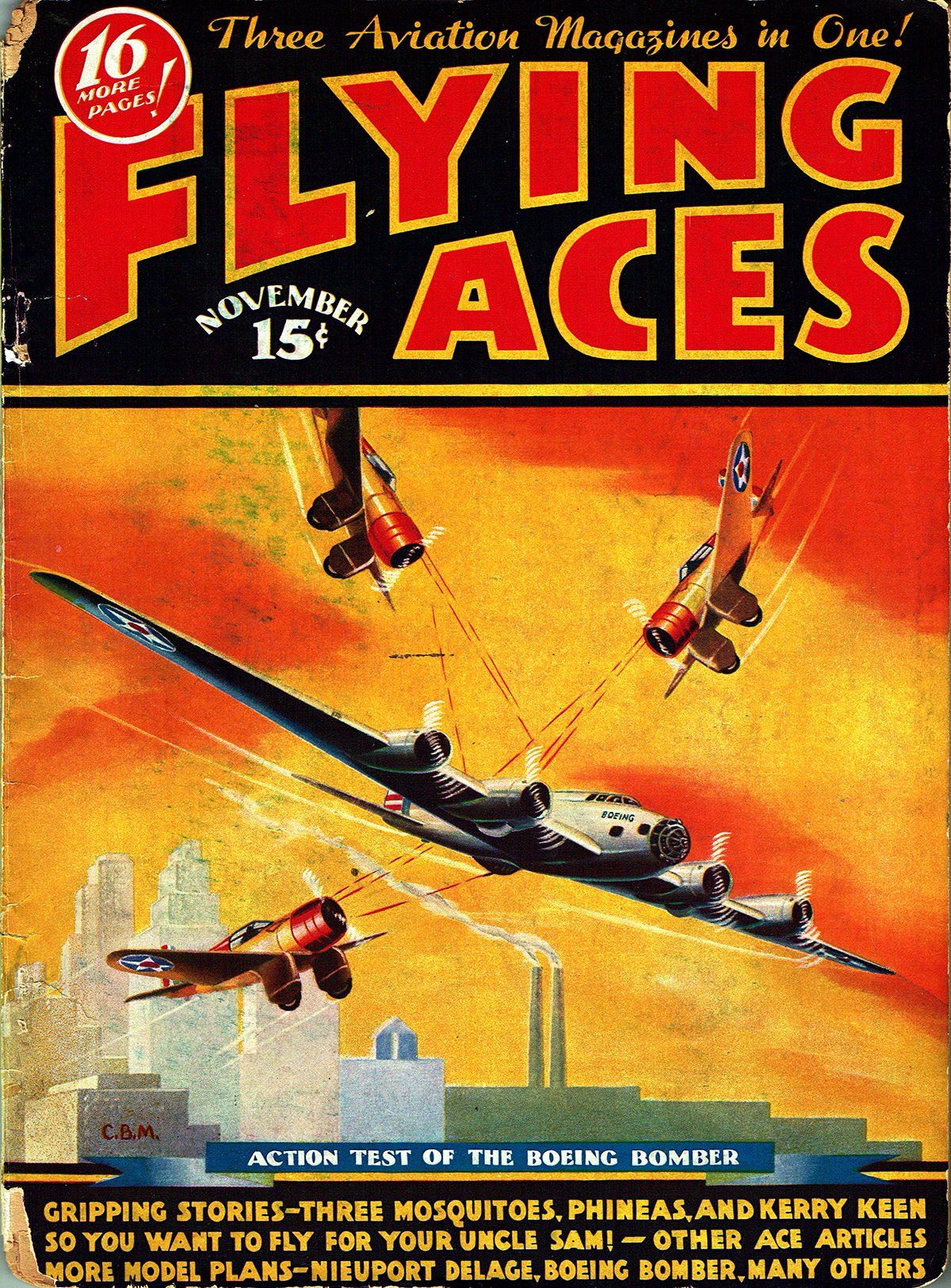“Flying Aces, November 1935″ by C.B. Mayshark
THIS May we are once again celebrating the genius that is C.B. Mayshark! Mayshark took over the covers duties on Flying Aces from Paul Bissell with the December 1934 issue and would continue to provide covers for the next year and a half until the June 1936 issue. While Bissell’s covers were frequently depictions of great moments in combat aviation from the Great War, Mayshark’s covers were often depictions of future aviation battles and planes, like November 1935’s thrilling story behind its cover in which Mr. Mayshark shows us what it might look like when they test the new Boeing Bomber!
Action Test of the Boeing Bomber
 OVER the distant horizon, a speck suddenly becomes visible from the housetops of a teeming industrial city. As if by magic, the speck grows in size, finally taking on gigantic proportions. Crowds in the streets are attracted, all eyes are turned heavenward. And now the aerial monster—the new Boeing Bomber—hurtles over the city at more than 250 miles per hour! This giant, powered by four Pratt & Whitney engines, is the newest thing in the air—the latest marvel of an age which already boasts innumerable mechanical wonders.
OVER the distant horizon, a speck suddenly becomes visible from the housetops of a teeming industrial city. As if by magic, the speck grows in size, finally taking on gigantic proportions. Crowds in the streets are attracted, all eyes are turned heavenward. And now the aerial monster—the new Boeing Bomber—hurtles over the city at more than 250 miles per hour! This giant, powered by four Pratt & Whitney engines, is the newest thing in the air—the latest marvel of an age which already boasts innumerable mechanical wonders.
Suddenly, the local airport is alive with activity. Three brand new Navy Northrops are speedily rolled from a hangar. Commands are curtly barked, starters whine, and the deafening roar of three powerful engines pervades the air. The single-seaters are off the ground with a leap; and once in the air, they head in Vee formation toward the circling bomber. Their job is a test attack on the immense ship before them. They must attempt, theoretically, to send it to destruction.
Will they be returned the victors? Will the Boeing Bomber, in supposition, go “down in flames?†Will the years of research and toil be written off as short of the goal?
In short, were the designers fully warranted in making this new swing in military aviation? At this writing, the answer seems to be an emphatic “Yes!†To begin with, the argument is advanced that the days of the single-seater hero pilot are gone forever. Already there are indications that present day single-seater squadrons may become somewhat outmoded before the advance of fast and powerful two- and three-seater attack jobs. This fact gives credence to the growing acceptance, in military circles, of the large capacity, long-range bomber, of which the new Boeing is the acme.
Of course, we all know of the romance and spirit of adventure which characterized the fighting of the daring war-time pilots. In those days it was generally a case of man against man. But today things are different.
There are those who declare that single-seaters have little chance against a four-engined giant with five gun platforms—a ship which cruises at better than 250 m.p.h. The present day fighters of less speed would, of course, have difficulty in getting within range. As for the faster fighters, it may be pointed out that it takes plenty of skill to hit a fast moving ship; and when you are forced to zig-zag and literally throw yourself all over the sky in order to escape burst after burst of withering fire from such a formidable flying fortress—it requires more than skill!
However, in spite of what the experts think, and in spite of what the consensus is among those who think they are experts, the new Boeing Bomber must be put to test. A violent encounter must be simulated.
And so, the Northrops appear on the scene. One of the finest single-seater types in the world, they are fast, powerful, highly maneuverable. If anything can get near the Boeing Bomber, the Northrop can.
Coming upon the bomber from behind, they spread out fan-wise as soon as the first warning burst of tracer sprays the air about them. One Northrop climbs, another maintains its position, and the other dives. Attack the ship from more than one angle! Close in on it! Throw tracer from all directions! Those are the accepted tactics.
But the Northrop pilots soon find their task difficult. The Boeing Bomber cannot safely be approached from any angle. It is protected from above by a turret along the top of the fuselage. A “bird cage†gun emplacement protects the nose of the ship. Moreover, guns bristle from “blister†turrets on both sides and belly of the bomber’s fuselage. There are no blind spots!
The gunners aboard the Boeing are wide awake to every movement of the Northrops. But even so, their task, too, is not the simplest one in the world. The shifty little Northrops are giving them the fight of their lives. But finally, the hugh bomber prevails.
AND so, the Boeing theoretically is successful in bombing the industrial center it has attacked. True, the city is also protected by anti-aircraft defences. But the speed at which the Boeing flies makes one sceptical as to the success of such fire. And this brings up an interesting question: Have anti-aircraft developments kept pace with plane developments? A city is a huge target for a bomber speeding at high altitudes—but to gunners on the ground the bomber is, of course, a very small and highly-elusive object. While we’ve heard rumors of super-effective anti-aircraft pieces, the powers that be have thus far kept such inventions well veiled.
As for our Northrops, they now land, and the pilots climb wearily from their cockpits, haggard, exhausted. They have been through an ordeal. The tight turns and steep power dives have told upon them; for the tricky maneuvering in the hurtling fighters of the present day exerts a terrific strain upon the body.
Of course, the air battle pictured on our cover is entirely fictitious. Our purpose has simply been to help you visualize the new Boeing Bomber in a real air scrap. If such a test takes place, there will be a board of judges to render a verdict as to the outcome. Blank cartridges or camera guns will be substituted for bullets.
Performance figures of the new Boeing have not been released. At this writing, its top speed is a matter of conjecture. Your guess is as good as ours.

Flying Aces, November 1935 by C.B. Mayshark
Action Test of the Boeing Bomber: Thrilling Story Behind This Month’s Cover




